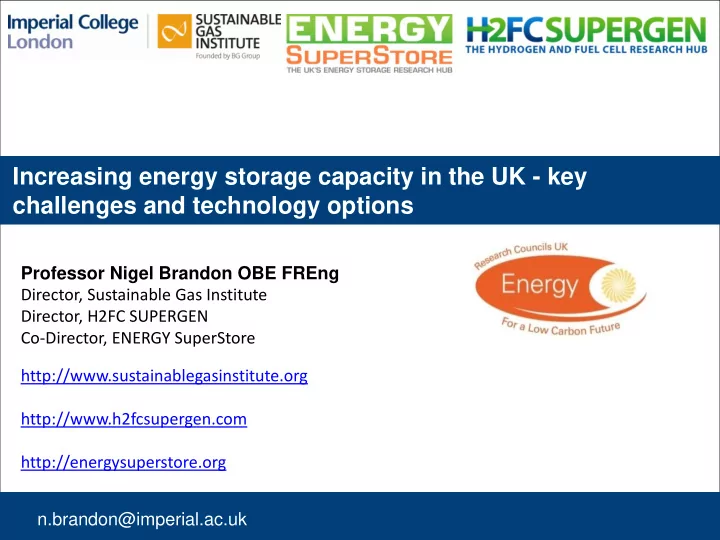

Increasing energy storage capacity in the UK - key challenges and technology options Professor Nigel Brandon OBE FREng Director, Sustainable Gas Institute Director, H2FC SUPERGEN Co-Director, ENERGY SuperStore http://www.sustainablegasinstitute.org http://www.h2fcsupergen.com http://energysuperstore.org n.brandon@imperial.ac.uk
Role and Value of Energy Storage – a UK study • The optimal location for bulk storage in the UK is in Scotland, where it supports the integration of wind and avoids additional transmission reinforcement with northern England. Distributed storage is predominantly located on networks in high demand regions in Southern GB, especially in conjunction with a high uptake of electrified transport and heating. • The value of storage in the UK increases markedly towards 2030 and further towards 2050. Carbon constraints for 2030 and 2050 can be met at reduced costs when storage is available. For bulk storage cost of £50 per kW per year, the optimal volume deployed grows from 2 GW in 2020 to 25 GW in 2050. The equivalent system savings for the UK alone can reach over £10bn per year in 2050. Strategic Assessment of the Role and Value of Energy Storage Systems in the UK Low Carbon Energy Future , Goran Strbac, Marko Aunedi, Danny Pudjianto, Predrag Djapic, Fei Teng, Alexander Sturt, Dejvises Jackravut, Robert Sansom, Vladimir Yufit, Nigel Brandon, Energy Futures Lab report for the Carbon Trust, June 2012 www.carbontrust.com/media/129310/energy-storage-systems-role-value-strategic- assessment.pdf
Impact of system flexibility on optimal generation mix for 50 and 100 g CO 2 /kWh targets in 2030
Storage Technology Options Energy storage technologies can be clustered into those that deliver: • Mostly energy (pumped hydro, compressed air, flow batteries, hydrogen, liquid air, pumped heat) • Mostly power (capacitors, flywheels) • Both power and energy (batteries) Of the latter there are high temperature batteries (Sodium-sulphur, sodium nickel chloride) and low temperature batteries (lithium ion. nickel metal hydride, lead acid), with the former often offering better cycle life but requiring energy to keep them at the correct temperature when not in use. We are likely to need storage services for both power and energy, hence a range of safe and affordable storage solutions must be developed, capable of sufficiently long lifetimes at sufficiently low cost.
http://energysuperstore.org/wp- content/uploads/2016/04/IMPJ4129_W hite_Paper_UK-Research-Needs-in-Grid- Scale-Energy-Storage- Technologies_WEB.pdf http://energysuperstore.org
Value of storage in future low Carbon energy systems DECC high renewables scenario Strategic assessment of the role and value of energy storage systems in the UK Low Carbon Energy Future, Report for Carbon Trust; G Strbac et al, (2012) Energy Futures Lab Imperial College London.
Energy storage technologies deployed on grid Analysis of the UK energy system indicates that installed energy storage capacity in the UK alone could reach 25 GW by 2050.
Conclusion 1: There is no Silver Bullet • We are likely to need storage services for both power and energy, hence a range of safe and affordable storage solutions must be developed, capable of sufficiently long lifetimes at sufficiently low cost. • Not only the storage technology is important, but also all the technologies associated with the integration, control and management of storage services. • The winning technologies will not necessarily be the ‘best’, but will be those with strong supply chains and global markets that can help drive down cost. • The UK has companies active in this sector with great technologies, and a strong research base to support it.
Conclusion 2: There is a Market Failure • We have built an energy system that relies on energy storage through fuel storage, such as coal and gas. Hence today the value of other forms of storage is relatively limited, other than in specific cases, or where markets are being created through incentives. • But energy storage is one of the key options for delivering the flexibility we will need in future low carbon energy systems, where the value of these services will be far higher. • Hence there is a market failure for storage developers – how can we ensure that the range of technologies we will need can be developed so that they can deliver at the right costs with the right lifetime at the right level of technology maturity, when needed.
Recommend
More recommend